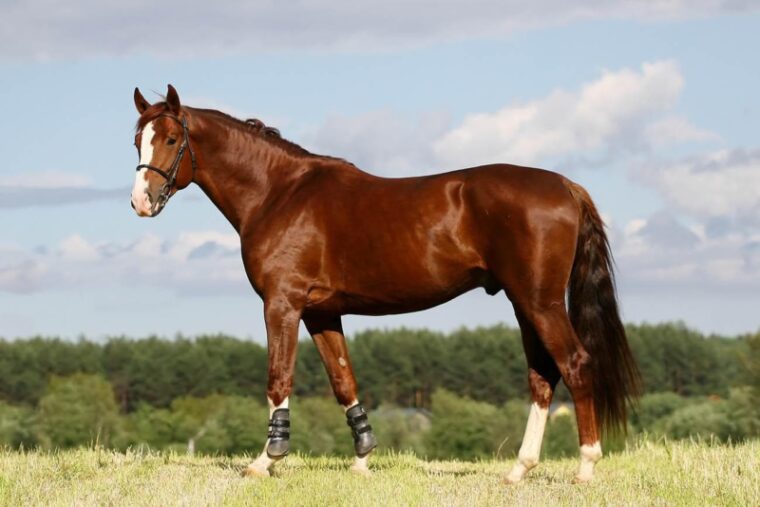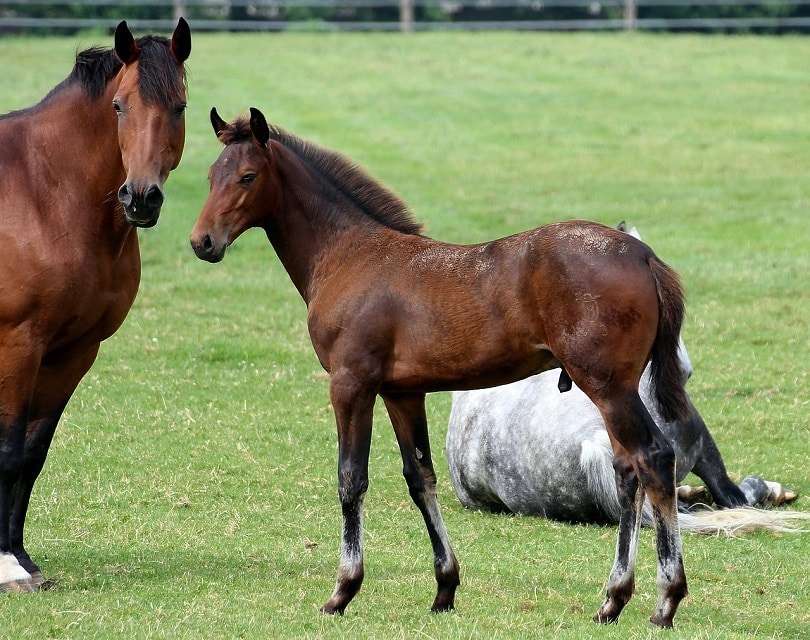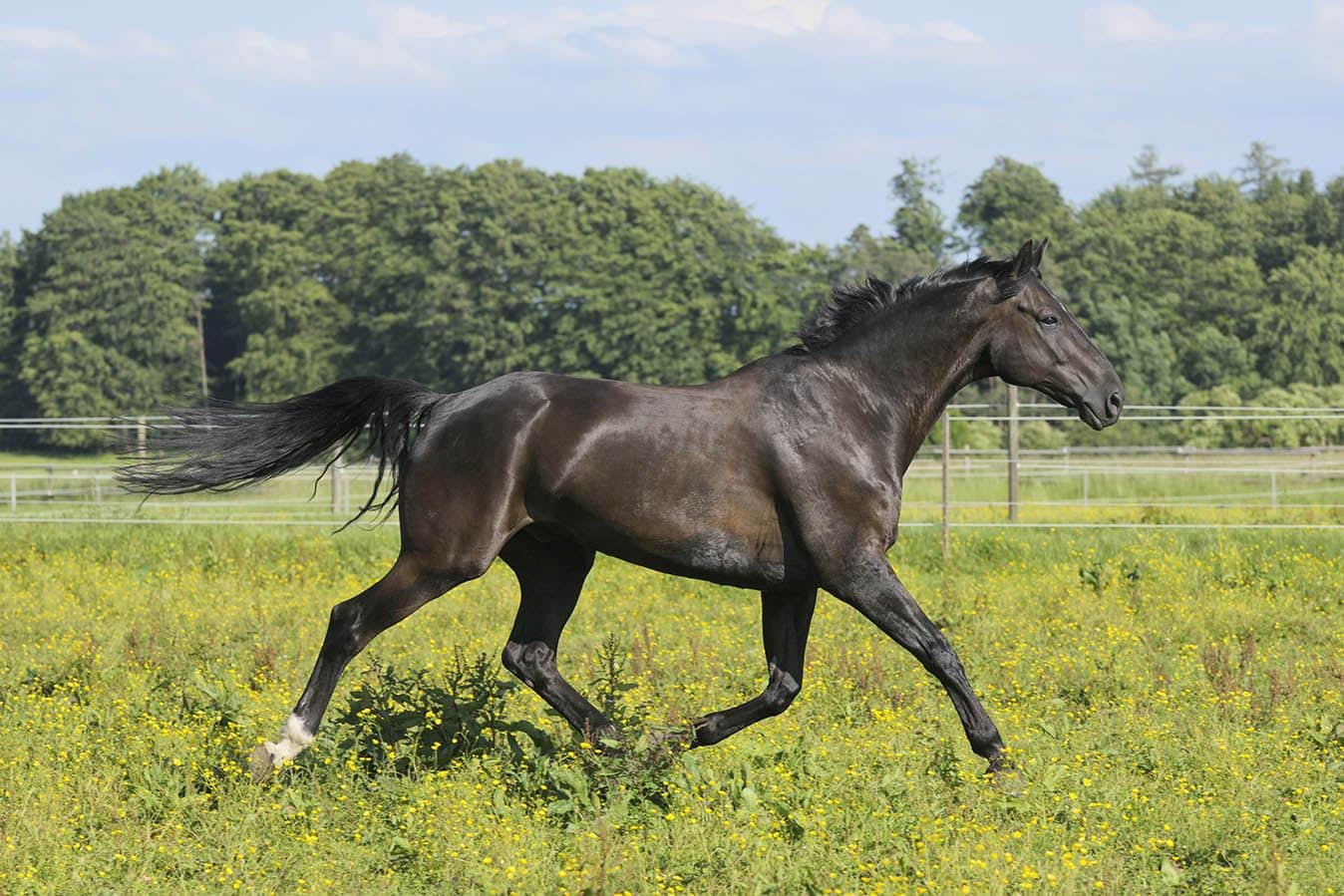
Germany has had a massive impact on the equine world and is the native land of many popular breeds today. The country has its fair share of ponies, warmbloods, and coldbloods that serve incredibly beneficial purposes to owners. Throughout the ages, duties might have changed—but their spirits have not.
If you want to brush up on your German equine knowledge, you’ve stumbled across the right page. Here are 17 of the most famous horse breeds from the land of poets and thinkers.
The 17 German Horse Breeds
1. Arenberg-Nordkirchen
The Arenberg-Nordkirchen is a smaller horse from Germany that is sleek and lean. In the 1880s, they were thought to be extinct. But they reemerged and have stayed stable since 1999.
The Arenberg-Nordkirchen breed started in 1923, compliments to the Duke of Arenburg and his estate horses. Today, they are considered extremely endangered.
The Arenberg-Nordkirchen comes in coats of bay, black, dun, chestnut, and gray.
Height: 13-13.5 hands
Weight: 800 pounds
Purpose: Sport, hobby
2. Bavarian Warmblood

The Bavarian Warmblood was developed in Southern Germany—a descendant of the proud Rottaler. You can find these unique horses on pleasure strolls and in competition.
The Bavarian Warmblood is known for its agility, stable gait, and effortless movements. They have a very rhythmic way of trotting.
This breed can be all solid colors, including sorrel, bay, and black. No white markings are allowed—otherwise, it is a breed defect.
Height: 15-16 hands
Weight: 1,000-1,300 pounds
Purpose: Jumping, show-jumping, dressage
3. German Classic Pony

This tufted-haired little cutie is the German Classic Pony. Although this is a relatively new breed creation, developed in 1965, they are scarce today. They weren’t even established as a German breed until 2001.
German Classic Ponies are stout and strong, able to withstand hard labor. It is a combination of the Shetland and Scottish Shetland ponies, primarily used for moderate work.
Any coat color is acceptable, but flaxen chestnut is the most prevalent.
Height: 11 hands
Weight: 400-425 pounds
Purpose: Riding, driving
4. German Riding Pony

Otherwise known as the Deutsche Reitpony, the German Riding Pony is a graceful, capable creature with attractive features. Essentially, people will describe these ponies as miniature versions of their German Warmblood cousins.
This pony would make a great choice for small or inexperienced riders. These equines are quick on their feet, moving with meaning.
German Riding Ponies can be a multitude of colors, including grullo, perlino, gray, brown, white, palomino, roan, champagne, dun, and buckskin.
Height: 13-14 hands
Weight: 700 to 800 pounds
Purpose: Dressage, jumping, riding
5. Hanoverian

The elegant Hanoverian has a major place in Olympic competitions. They are English riding-style horses, completely competitive and charming.
Hanoverians had extreme popularity throughout World War I. Even with population decline, these horses remained throughout the years, being an equine of great importance today.
These horses can be gray, bay, chestnut, and black.
Height: 15-17 hands
Weight: 1,400 pounds
Purpose: Competition, Olympics
6. Hessian Warmblood
Hessian Warmbloods are excellent at pulling their weight—and everyone else’s. These horses are top choices for light and heavy riders. They have an eloquent essence, allowing a rider to feel ease and comfort.
They are considered a first-class German breed, having an unwavering gait. They have a relaxed, precise stance and well-timed movements.
Hessian Warmbloods can come in a broad spectrum of colors, but are most often chestnut and brown.
Height: 15-16 hands
Weight: 1,000 pounds
Purpose: Riding
7. Holsteiner

The magnificent Holsteiner is thought to be the oldest warmblood breed in Germany. These talented horses are skilled in many areas of expertise.
You might find one of these horses in eventing, dressage, combined driving, and show jumping. Holsteiners have a branded mark on their left hip to prove their status. These equines are sought after and admired by horse lovers everywhere.
Holsteiners can be black, brown, bay, chestnut, and gray.
Height: 16 to 17 hands
Weight: 1,025 pounds
Purpose: Eventing, dressage, show jumping
8. Mecklenburger
The Mecklenburger is a warmblood but has a mid-range weight—both athletic and precise. They are said to have a very well-balanced temperament, making them reposed.
The Mecklenburger is a swift German horse that was once a utility horse. After the war, they were used as carriage or saddle horses. Things took a turn in the 1970s when the Mecklenburger took on other tasks as a sport horse.
Mecklenburgers can be chestnut, black, bay, or gray.
Height: 15-17 hands
Weight: 1,000 pounds
Purpose: Combined driving, eventing, competition
9. Oldenburg Horse

Oldenburg horses are workers through and through. Originally, they helped farmers till heavy soil in tough terrain.
Today, the Oldenburg Association protects the authenticity of the breed. They are part of a breeding program and train as show jumpers.
The Oldenburg is chestnut, bay, brown, black, and gray.
Height: 16-17 hands
Weight: 1,700 pounds
Purpose: Jumping, dressage, riding
10. Trakehner

The Trakehner is a light warmblood, earning a title as Germany’s most refined. It was carefully crafted through selective breeding of the Thoroughbred, Shagya, and Arabian horses.
These beauties are intelligent and even-keeled. They tend to train well and compete in agility events and dressage. Back in the day, they took on all sorts of tasks from farm work to cavalry.
The Trakehner can be a wide array of colors like chestnut, gray, bay, roan, and tobiano.
Height: 15-17 hands
Weight: 1,500 pounds
Purpose: Dressage, show jumping
11. Rhenish German Coldblood

The distinguished Rhenish German Coldblood is a gentlemanly sort. These slow-paced sweethearts have used their muscle power for years, helping out land workers.
In 2007, these gorgeous creatures were marked as endangered, but the numbers finally began to recover.
The two primary colors of Rhenish German Coldbloods are roan and chestnut.
Height: 15-16 hands
Weight: 1,100 pounds
Purpose: Agriculture
12. Rhenish Warmblood

The lovely Rhenish Warmblood is a German sport horse. It has ties to the Bavarian Warmblood, Mercklenburger, and Brandenburger.
This horse has a very pleasing trot and canter. The Rhenish Warmblood is charming and sophisticated in motion.
The Rhenish Warmblood is chestnut as a breed standard.
Height: 15 to 17 hands
Weight: 1,000 to 1,300 pounds
Purpose: Dressage, show jumping
13. Rottaler

Dating all the way back to the middle ages, the Rottaler horse is a timeless beauty. It is the only indigenous breed of Bavaria, being a heavy and light warmblood horse.
Rottalers have amiable personalities that make them easy to train. However, they are an ultra-rare, extremely old breed that is particularly hard to find.
Rottalers are usually black or dark brown but can be virtually any color.
Height: 16-17 hands
Weight: 1,100 pounds
Purpose: Pulling, agriculture
14. Schleswig Coldblood

The Schleswig Coldblood is one of Germany’s classic draught horses. They are medium-sized, sturdy horses with an excellent work ethic and even temperament.
This breed dipped down into the endangered list in 2013 and numbers have decreased since.
These horses are usually flaxen chestnut, but they can be gray as well.
Height: 15-16 hands
Weight: 1,100 pounds
Purpose: Agriculture
15. Black Forest Horse

This breathtaking horse is an incredibly scarce German breed that is highly endangered today. They are a draught breed but are quite small in comparison to others of their likeness.
These horses are said to be exceptionally friendly and kind to humans and animals alike. They also tend to make fantastic mothers.
The dark coat against the silvery mane makes for a gorgeous contrast. These horses can be any shade of chestnut with a dark fox mane and tail.
Height: 14-15 hands
Weight: 1,000 pounds
Purpose: Pulling, riding
16. Senner

Senner horses are said to be the oldest saddle horse in Germany. Today, these muscular, capable horses are critically endangered with diminishing numbers.
The once-feral horses date all the way back to the medieval days. They are generally known as excellent riding horses but are unlikely to be found.
The Senner can be bay and gray or black and chestnut.
Height: 16-17 hands
Weight: 1,100 pounds
Purpose: Riding
17. Zweibrucker
The Zweibruker is a German Warmblood horse that is divine in competition. There is a brand that identifies this horse on their left hind leg—an unmistakable duke crown.
This breed is a performer, suited for dressage, eventing, and sometimes combined driving. The Zweibruker is considered a highly versatile horse.
The Zweibruker can come in quite a few colors, including chestnut, gray, bay, pinto, cream, buckskin, and palomino.
Height: 16-17 hands
Weight: 850 pounds
Purpose: Dressage, show jumping, combined driving
Wrapping Up
It’s intriguing how much history is involved with German horse breeds. Some of these horses predate domestication, which is crazy to consider. Germany offers horse breeds that perform a variety of tasks and fulfill duties specific to the horse.
Of all these elegant, charming horses, which one caught your eye over the rest?
Featured Image Credit: Alexia Khruscheva, Shutterstock








